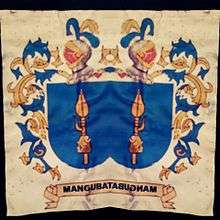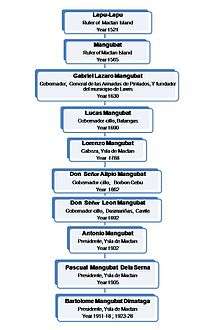Mangubat (surname)
| Mangubat | |
|---|---|
 Mangubat's 16th century Coat of Arms | |
| Pronunciation | mang-gubat |
| Origin | |
| Language(s) | Cebuano, Old tagalog, Subanen, Tuwali, Pampango |
| Meaning | " To wage war " |
| Other names | |
| Variant(s) | Manguerra |
Mangubat (Mang-gubat) (Spanish: Guerrear);[1] is a Filipino surname of Mactan Island origin which means "to wage war"[2][3] It belongs to a noble lineage according to Vicente de Cadenas y Vicent[4] Chronicler King of Arms of the Kingdom of Spain and the last Cronista Rey de Armas appointed by the Spanish Ministry of Justice.
The Mangubat surname were members of the Spanish nobility class and had an Azure shield, with a vertical gold pike or pica, put on stick.[lower-alpha 1][5] Mangubat when related to a name, it usually means marauders, pirates and warriors in the Visayas.
Antonio de Morga, in his book published in 1609 Sucesos de las Islas Filipinas (Events of the Philippine Islands), mentions that the term means "to go to war and raid for plunder and described the native as a race less inclined to agriculture and eager for war and raids for pillage and booty".[6][7] the term was also used by Francisco Baltazar (1778–1862) in his 1838 book Florante at Laura to means "to go for battle".[8] The term is derived from two Filipino words – the verb mang (to do) and the noun gubat (war).[9] "Gubat" is a common word for war in the language of the Visayans,the ancient Tagalog,[10] the Ilocano people,[11] the Igorot people,[lower-alpha 2] in Mindanao, and in the Autonomous Region in Muslim Mindanao.[lower-alpha 3]
Major Distribution in the Philippines since 16th Century
Major Distribution in other countries
Etymology
The term is ancient, appearing in both noun and verb forms in the books contemporaneous with the pintados age.
A mangubat was a man who left his homeland, family, and people for war adventure, mainly for tattooing for honor and fame or sometimes for slave-raiding, with the implication that he planned to return home with his newly won fortune and fame. It does not include the concept of staying in the place one has conquered for in the Pintados culture for one to have a tattoo one must prove himself in battle.
The word existed in both a noun form (mangubat, the person traveling for war adventure)[12] and a verb form (mangubat, to travel for war or participate in one of these adventures).
Coat of arms
Mangubat was a Spanish Military Order formed in the 16th century. It belongs to the native conquistadores of Mactan who allied with the Spaniards as Datu Mangubat of the kingdom of Mactan was converted to Christianity (he was the son and successor of Lapu-Lapu )
The military unit have a coat of arms, or emblems to distinguish them from other military units,and was the most elite and warlike spanish military order of the Spanish East Indies and in the whole Spanish empire at the time as depicted in their Coat of arms. The coat was granted under the strict rules, and requirements of Heraldry rewarded for destroying the muslim kingdoms of Luzon and in Mindanao whose leaders at one time promised to pay tributaries to Spain and until the time it revolted in the 1600 taking advantaged of the revolutions made by Christians in Luzon and in different parts of the Country
Symbolism
The Azure shield Signify Blue Blooded, Royalty and Nobility.Justice, Truth, and Loyalty.
The Pica(Pike) represent Honorable Warrior and Valiant Knight, emblem of gallant Military and Knightly service, The perfection of Martial affairs. In contrast to the lance that stands for, Strength and Prudence. The pike symbolizes Military Valor, Strength, and Prudence
The gold Pica(pike) means noble and conquistador or Spanish Hidalgo.
The stick means Jurisdiction and authority.
Brief description of the Mangubat warriors
"Their weapons consist of large knives curved like cutlasses (Sanggot), spears (Bancao,bangkaw) and caraças (shields). They employ the same kinds of boats as the inhabitants of Luzon. They have the same occupations, products, and means of gain as the inhabitants of all the other islands (i.e. Islands of the Visayas and Mindanao). These Visayans which they call Mangubat are a race less inclined to agriculture, and are skilful in navigation, and eager for war and raids for pillage and booty. Mangubat, this means "to go out for plunder." [13][14]
Mangubat people

- si Mangubat – was a datu of Mactan during the time of Legaspi
- Lazaro Mangubat – (fl. 1630), was gobernadorcillo on Bantayan island.
- Lucas Mangubat – (1690), was gobernadorcillo of Batangas (i.e. municipal judge or governor in the Philippines during the Spanish colonial period).[15][16]
- Lorenzo Mangubat – (ca. 1700s) was a cabeza (i.e. the municipal chief or head under Spanish colonial times) of Opon( Now Lapu–Lapu City)[17]
- Alejandro Mangubat – was a cabeza of Opon
- Don Alipio Mangubat - (ca. 1862) was Gobernador-cillo of Borbon, Cebu
- Don Leon Mangubat – (ca. 1892) was a gobernadorcillo of Dasmariñas Cavite[18]
- Antonio Mangubat – (Lapu–Lapu first municipal president under the American regime, year 1902)[19][20]
- Tomasa Mangubat – she was the mother of Pascual dela Serna the last juez de paz of Lapu–Lapu and the first elected municipal president of Lapu–Lapu City.[21][22] The visita chapel where Sr. San Roque was enshrined is said to have been entrusted to the Mangubat family, up to the time when Tomasa Mangubat, a daughter of Alejandro Mangubat married the first Rito dela Serna in the 1800s.
- Dominador I. Mangubat – (1904–1980), is a former Dasmariñas, Cavite governor; former member of (FACGF) Fil-American Cavite Guerilla Force – World War II.[23]
- Isidro Mangubat – municipal president (1925–1927) of Dasmariñas Cavite.
- Doroteo Mangubat – municipal president (1934–1935) of Dasmariñas Cavite.
- Pedro Mangubat – (Borbon, Cebu 1st municipal president under the American regime)[24]
- Santiago Mangubat – (Borbon, Cebu 3rd municipal president under the American regime)[24]
- Monteno Mangubat – (Borbon, Cebu 4th municipal president under the American regime)[24]
- Rev. Dr. Osbaldo Mangubat Padilla – the first Filipino priest to enter the Vatican Academy of Diplomacy and presently the Papal Nuncio to Korea and to Mongolia; Previous Posts: Apostolic Nuncio to Panama, Apostolic Nuncio to Sri Lanka, Apostolic Nuncio to Nigeria, Apostolic Nuncio to Costa Rica; Current Post: Apostolic Nuncio to Korea and Apostolic Nuncio to Mongolia; In Current office Since: April 26, 2008 ; Nuncio Since: 17 Dec 1990 – Present.[25]
- Norsem Mangubat – spokesperson of the Regional Committee of the Communist Party of the Philippines, Central Mindanao [26]
- Rubio Manggubat – spokesperson New People's Army, Eastern Samar (Sergio Lobina Command).[27]
- Jaime Virata Mangubat, M.D. (1927 Manila – 2012 Wayne County, Tennessee, United States) – the street to Wayne County General Hospital was named J. V. Mangubat Drive in his honor. In 2007, the Tennessee Legislature honored him by proclaiming April 13 as Dr. J. V. Mangubat Day.[28]
History
Notes
- ↑ The symbol of authority. see: sceptre and baton (military)
- ↑ in the Ilocos Region and Cordillera Administrative Region (i.e. the Ifugao and the Igorot people)
- ↑ Tausūg people, and Maranao people
References
- ↑ P. Jacinto, Juanmartí (1892). Diccionario moro-maguindanao-español, compuesto por el P. Jacinto Juanmartí de la Compañía de Jesús. Author. AMIGOS DEL PAIZ. p. 120. Retrieved 9 August 2015.
- ↑ Philippine Social Sciences and Humanities Review,Volumes 13–15. College of Liberal Arts, University of the Philippines, 1941. 1941. p. 125.
- ↑ Morrow, Paul (1 July 2010). "Clavería's catalogue". Retrieved 16 July 2015.
- ↑ "UC blog". Retrieved 10 January 2016.
- ↑ Luis de Salazar y Castro (1964). Repertorio de blasones de la comunidad hispánica,and were part of the Spanish nobility. Volume 1, edited by Instituto Luis de Salazar y Castro. Instituto Luis de Salazar y Castr. p. 1077. Retrieved 10 January 2016.
- ↑ Rizal, José (1962). Historical events of the Philippine Islands by Antonio de Morga. 270: José Rizal National Centennial Commission, 1962. Retrieved 26 July 2015.
- ↑ Antonio de Morga. "History of the Philippine Islands". Retrieved 16 July 2015.
- ↑ Castro, Jovita Ventura (1985). Philippine metrical romances. ASEAN Committee on Culture and Information, 1985 – English poetry Translations from Tagalog. p. 344 of 403. Retrieved 26 July 2015.
- ↑ "Philippine Studies Committee, Southeast Asia Council, Association for Asian Studies, 1996" (26–29). 1996: 187. Retrieved 13 July 2015.
- ↑ de Noceda, Juan [José] (1860). Vocabulario de la lengua tagala [microform]. Noceda, Juan [José] de, 1681–1747; American Philosophical Society. Library; Sanlucar, Pedro de. p. 526. Retrieved 9 March 2016.
- ↑ R. Galvez Rubino, Carl R. Galvez. Ilocano Dictionary and Grammar: Ilocano–English, English–Ilocano. p. 204. Retrieved 26 July 2015.
- ↑ Tiemeyer, Bertram Tiemeyer (2001). Suk tandään nängak Subanän: ang mitolohiya, mga pagtoo ug mga ritwal ug seremonyas sa mga Subanän. p. 293 of 1081. Retrieved 31 December 2015.
- ↑ Braganza, José Vicente (1965). The Encounter: The Epic Story of the Christianization of the Philippines. Manila: Catholic Trade School 1965. (1965). p. 235.
- ↑ de Morga, Antonio (1609). Sucesos de las islas Filipinas por el doctor Antonio de Morga, obra publicada en Méjico el an̄o de 1609. nuevamente sacada à luz y anotada por José Rizal y precedida de un prólogo del prof. Fernando Blumentritt. p. 288.
- ↑ "History of Bauan". bauan.gov.ph. Retrieved 24 April 2013.
- ↑ HISTORY AND CULTURAL LIFE OF BUAUN POBLACION (PDF). p. 1. Retrieved 23 August 2015.
- ↑ Desabelle, Gerry Yaun (1988). Lapulapu City: Its Role in the Birth of the Filipino Nation. Lapu Lapu City: G.Y. Desabelle, 1988 – Lapulapu (Philippines). p. 20.
- ↑ de Santa Inés, Fray Francisco (1676). Cronica de la provincia de San Gregorio Magno de religiosos Descalzos de N. S. P. San Francisco en las islas Filipinas, China, Japon, etc., escrita en 1676 (Manila: Tipo–litografia de Chofre comp., 1892). p. 669. Retrieved 23 August 2015.
- ↑ Yaun Desabelle, Gerry (1988). Lapulapu City: Its Role in the Birth of the Filipino Nation. Lapulapu (Philippines). p. 22.
- ↑ Report of the Philippine Commission to the Secretary of War. Philippines: U.S. Government Printing Office. 1904. p. 803.
- ↑ Desabelle, Gerry Yaun Desabelle (1988). Lapulapu City: Its Role in the Birth of the Filipino Nation. p. 20.
- ↑ Oaminal, Clarence Paul (April 17, 2014). "The Cebuano candidates in the 1971 Senatorial Elections". The Freeman (PhilStar). Retrieved 4 May 2014.
- ↑ del Rosario, Dominador A. "DOMINADOR I. MANGUBAT (1954 – 1955)". The Official Website of Provincial Government of Cavite. Retrieved 29 March 2013.
- 1 2 3 "Municipality of Borbon, Cebu Oficial website". borboncebu.net. Retrieved 5 April 2013.
- ↑ "ECCLESIASTICA DIPLOMATICA". vaticandiplomacy.org. Retrieved 4 May 2013.
- ↑ "NPA posts significant gains in north central Mindanao region". philippinerevolution.net. Retrieved 17 May 2013.
- ↑ "NPA to go after Samar councilor for 'extortion'". GMA Network News. April 20, 2010. Retrieved 16 April 2014.
- ↑ "Obituary". www.legacy.com. Retrieved 2 June 2014.